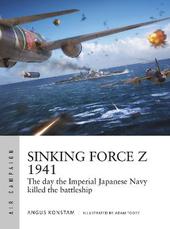
|
Sinking Force Z 1941: The day the Imperial Japanese Navy killed the battleship
Paperback / softback
Main Details
| Title |
Sinking Force Z 1941: The day the Imperial Japanese Navy killed the battleship
|
| Authors and Contributors |
By (author) Angus Konstam
|
|
Illustrated by Adam Tooby
|
| Series | Air Campaign |
|---|
| Physical Properties |
| Format:Paperback / softback | | Pages:96 | | Dimensions(mm): Height 248,Width 184 |
|
| Category/Genre | Second world war |
|---|
| ISBN/Barcode |
9781472846600
|
| Classifications | Dewey:940.545941 |
|---|
| Audience | | General | | Professional & Vocational | |
|---|
| Illustrations |
Illustrated throughout with around 60 photos and at least 14pp of colour illustrations
|
|
Publishing Details |
| Publisher |
Bloomsbury Publishing PLC
|
| Imprint |
Osprey Publishing
|
| Publication Date |
21 January 2021 |
| Publication Country |
United Kingdom
|
Description
A history and analysis of one of the most dramatic moments in both air power and naval history. With the sinking of HMS Prince of Wales and Repulse, no battleship was safe on the open ocean, and the aircraft took its crown as the most powerful maritime weapon In late 1941, war was looming with Japan, and Britain's empire in southeast Asia was at risk. The British government decided to send Force Z, which included the state-of-the-art battleship Prince of Wales and the battlecruiser Repulse, to bolster the naval defences of Singapore, and provide a mighty naval deterrent to Japanese aggression. These two powerful ships arrived in Singapore on 2 December - five days before the Japanese attack on Pearl Harbor. But crucially, they lacked air cover. On 9 December Japanese scout planes detected Force Z's approach in the Gulf of Thailand. Unlike at Pearl Harbor, battleships at sea could manoeuvre, and their anti-aircraft defences were ready. But it did no good. The Japanese dive-bombers and torpedo-bombers were the most advanced in the world, and the battle was one-sided. Strategically, the loss of Force Z was a colossal disaster for the British, and one that effectively marked the end of its empire in the East. But even more importantly, the sinking marked the last time that battleships were considered to be the masters of the ocean. From that day on, air power rather than big guns would be the deciding factor in naval warfare.
Author Biography
Angus Konstam hails from the Orkney Islands, and is the author of over 100 history books, 60 of which are published by Osprey. This acclaimed author has written widely on naval history, from Sovereigns of the Seas and Piracy: The Complete History to his most recent bestseller, Hunt the Bismarck. A former naval officer and museum professional, he worked as the Curator in both the Royal Armouries, Tower of London and the Mel Fisher Maritime Museum in Key West, Florida. He now works as a full-time author and historian, and lives in Orkney, Scotland.
|